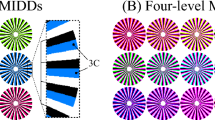Abstract
THE motion after-effect occurs after prolonged viewing of motion; a subsequent stationary scene is perceived as moving in the opposite direction1,2. This illusion is thought to arise because motion is represented by the differential activities of populations of cortical neurons tuned to opposite directions; fatigue in one population leads to an imbalance that favours the opposite direction once the stimulus ceases3. Following adaptation to multiple directions of motion, the after-effect is unidirectional4–6, indicating that motion signals are integrated across all directions. Yet humans can perceive several directions of motion simultaneously7–10. The question therefore arises as to how the visual system can perform both sharp segregation and global integration of motion signals. Here we show in computer simulations that this can occur if excitatory interactions between different directions are sharply tuned while inhibitory interactions are broadly tuned. Our model predicts that adaptation to simultaneous motion in opposite directions will lead to an orthogonal motion after-effect. This prediction was confirmed in psychophysical experiments. Thus, broadly tuned inhibitory interactions are likely to be important in the integration and segregation of motion signals. These interactions may occur in the cortical area MT, which contains motion-sensitive neurons with properties similar to those required by our model11–14.
This is a preview of subscription content, access via your institution
Access options
Subscribe to this journal
Receive 51 print issues and online access
$199.00 per year
only $3.90 per issue
Buy this article
- Purchase on Springer Link
- Instant access to full article PDF
Prices may be subject to local taxes which are calculated during checkout
Similar content being viewed by others
References
Addams, R. Lond. Edinb. Phil. Mag. J. Sci. 5, 373–374 (1834).
Hiris, E. & Blake, R. Proc. Natl Acad. Sci. USA 89, 9025–9028 (1992).
Wohlgemuth, A. Br. J. Psychol. (Mono. Supp.) 1, 1–117 (1911).
Mather, G. Perception 9, 379–392 (1980).
van Doorn, A. J., Koenderink, J. J. & van de Grind, W. A. Perception 14, 209–224 (1985).
Verstraten, F. A. J., Fredericksen, R. E. & van de Grind, W. A. Vision. Res. 34, 349–358 (1994).
Nakayama, K. Vision Res. 25, 625–660 (1995).
Adelson, E. H. & Movshon, J. A. Nature 300, 523–525 (1982).
Braddick, O. Trends Neurosci. 16, 263–268 (1993).
Stoner, G. R., Albright, T. D. & Ramachandran, V. S. Nature 344, 153–155 (1990).
Albright, T. D. J. Neurophysiology 52, 1106–1130 (1984).
Snowden, R. J., Treue, S., Erickson, R. G. & Andersen, R. A. J. Neurosci. 11, 2768–2785 (1991).
Newsome, W. T., Britten, K. H. & Movshon, J. A. Nature 341, 52–54 (1989).
Tootell, R. B. H. et al. Nature 375, 139–141 (1995).
Clarke, P. G. H. Vision Res. 17, 1243 (1977).
Sutherland, N. S. Q. J. Exp. Psychol. 13, 222–228 (1961).
Grunewald, A. in Advances in Neural Information Processing Systems Vol. 8 (eds Touretzky, D. S., Mozer, M. C. & Hasselmo, M. E.) 837–843 (MIT Press, Cambridge, Massachusetts, 1996).
Hubel, D. H. & Wiesel, T. N. J. Physiol. 195, 215–243 (1968).
Grossberg, S. Biol. Cybern. 23, 121–134 (1976).
Heeger, D. J., Simoncelli, E. P. & Movshon, J. A. Proc. Natl Acad. Sci. USA 93, 623–627 (1996).
Grossberg, S. Math. Biosci. 15, 253–285 (1972).
Giaschi, D., Douglas, R., Marlin, S. & Cynader, M. J. Neurophys. 70, 2024–2034 (1993).
Verstraten, F., Frederickson, R. E., Grüsser, O. J. & van de Grind, W. A. Vision Res. 34, 1149–1155 (1994).
Mulligan, J. B. Vision Res. 33, 2021–2030 (1993).
Mingolla, E., Todd, J. T. & Norman, J. F. Vision Res. 32, 1015–1031 (1992).
Watamaniuk, S. N. J., Sekuler, R. & Williams, D. W. Vision Res. 29, 47–59 (1989).
Bradley, D. C., Qian, N. & Andersen, R. A. Nature 373, 609–611 (1995).
Qian, N., Andersen, R. A. & Adelson, E. H. J. Neurosci. 14, 7357–7366 (1994).
Hiris, E. & Blake, R. Vis. Neurosci. 13, 187–197 (1996).
Author information
Authors and Affiliations
Rights and permissions
About this article
Cite this article
Grunewald, A., Lankheet, M. Orthogonal motion after-effect illusion predicted by a model of cortical motion processing. Nature 384, 358–360 (1996). https://doi.org/10.1038/384358a0
Received:
Accepted:
Issue Date:
DOI: https://doi.org/10.1038/384358a0
This article is cited by
-
Engaging and disengaging recurrent inhibition coincides with sensing and unsensing of a sensory stimulus
Nature Communications (2017)
-
Recurrent network dynamics reconciles visual motion segmentation and integration
Scientific Reports (2017)
-
Bifurcation analysis applied to a model of motion integration with a multistable stimulus
Journal of Computational Neuroscience (2013)
-
Neural population representation hypothesis of visual flow and its illusory after effect in the brain: psychophysics, neurophysiology and computational approaches
Cognitive Neurodynamics (2012)
-
Seeing multiple directions of motion—physiology and psychophysics
Nature Neuroscience (2000)
Comments
By submitting a comment you agree to abide by our Terms and Community Guidelines. If you find something abusive or that does not comply with our terms or guidelines please flag it as inappropriate.



